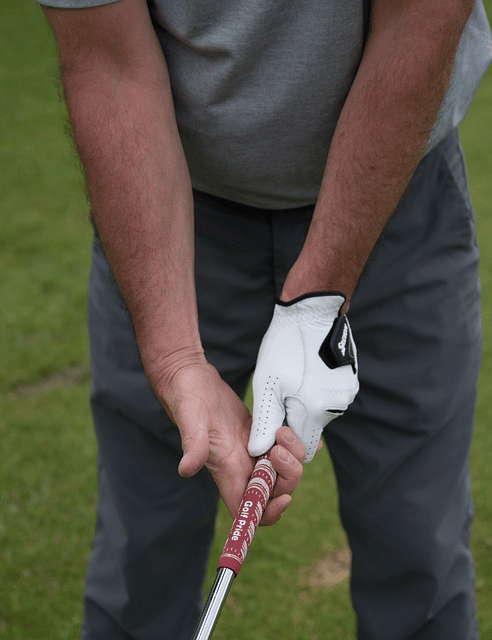Breaking 100 in golf is the first true milestone any golfer can hope to achieve. While there are other small victories like hitting your first draw or making your first par, those pale compared to the joy you feel when you play well for a full 18 holes of golf and card a score under 100.
To break 100 in golf, you’ll want to start with the right grip with palms each other, especially best for beginners. Get your alignment right by ensuring your body is parallel to your target. Being comfortable with these seemingly simple tasks will provide more confidence and less chance of having disastrous holes.
Whether you shoot 124 or 101, breaking 100 in golf consistently requires focus on these key elements to put the 100s behind you and start enjoying scores that will impress your friends.
Of course, there are several areas you could improve on, and there may be one or two that could significantly improve your game today.
Read on to learn more and come up with a plan so you can break 100 in golf.
How To Break 100 in Golf
To break 100 consistently, you must be very confident in the fundamentals of the game, including grip, alignment, and ball position. Having these foundations ingrained in your game will reduce your poor shots so you can shoot scores that are sub-100.
Golf is unique because there are many aspects to work on and improve. If you’re not breaking 100 consistently, focus your efforts on these three key areas to expedite the improvement process.
Grip

Many amateurs and those just starting out don’t put enough effort into holding the club properly. This is a huge flaw and will come back to bite you later in your career once you start learning how to manipulate the ball flight.
There are multiple correct ways to hold the club, but they all have these traits in common:
Palms Facing Each Other: You will have one hand above the other, but both palms should be on either side of the grip. It’s common for the lower hand to have the palm facing down, which causes slices.
Thumbs Pointing Down: Both thumbs should be on top of the shaft and pointing straight toward the ball. This will help ensure a neutral clubface and can also indicate where your palms are facing.
Grip With Your Fingers: Always have the club supported but the lower half of your fingers. Do not use your palms. This can be tricky to get used to because it’s more natural to hold something in the palm of your hand, but in golf, we have to be responsive, and holding the club in your fingers is how we do that.
Alignment
What’s the point of having a good swing if you can’t control where your ball goes? So many new players think they are missing their target with a poor swing when the swing is fine; they are just pointed the wrong way.
When practicing, always choose a target and ensure your body line is parallel to your target line. These two imaginary lines can be thought of as the two rails of a train track; they will never intersect and should always be parallel.
Ball Position
This is something that will not change drastically throughout your entire career. Get it right now, and you won’t have to worry about it for a long time. Before long, you won’t even think about it as it’s one of the things that will come naturally to you.
With wedges and high irons, your ball should be in the middle of your stance. As the clubs get longer in your bag, the position moves closer to your front foot along your imaginary target line. Your distance away from the ball is determined by whichever club you choose.
Can Your Short Game Help You Break 100?
You may hate to hear this, but your short game keeps you from breaking 100 in golf and will impede your ability to break through other milestones. Any pro or experienced golfer will tell you that scores aren’t made off the tee; they are made from inside 100 yards.
Putting Is Everything
Three-putts are a killer and a surefire way to inflate your score. There is never a reason to three-putt; you must be good from within five feet to avoid this. Practice this every day, no questions asked. The good news about this aspect of your game is that you can easily practice it at home.
There are two things to worry about for every putt you ever take: direction and speed. These are also called line and weight.
Your direction is the ability to read breaks and can be measured by how far left or right you miss the cup. Weight or speed is measured by how far short or long you miss. Focus on weight because that will stay more constant throughout a round than direction.
Some putts may break more than others, but all 18 greens will run at the same speed (in most cases). If you get your weight correct for the day, you will significantly decrease your number of three-putts and be on your way to breaking 100 consistently.
Chipping
Think of chipping as an extension of your putting. If you’re close to the collar of the green, then look to chip it close and putt it in from there. Like putting, this requires little technique and more touch. This is the artistic part of the game beginners and new golfers can excel at.
Blading wedges across the green is not how to break 100 in golf. If you struggle in this area, then this is your calling to get out there and practice. Don’t avoid aspects of your game simply because they don’t come naturally to you. Golf, in general, is unnatural, so embrace that and make your weaknesses become strengths.
What Practice Drills Can Help You Break 100?
All the golf tips for breaking 100 don’t mean much if you can’t implement them. Use these golf drills to improve the essential aspects of your game first before getting too detail-oriented. There will be plenty of time for that in your career.
1. Fix Your Slice
Odds are if you miss, you miss with a big sweeping slice that sails off into the woods, never to be heard from again. This racks up the penalty strokes and keeps your average score over 100. To straighten out your shots, use this drill either inside or at the driving range.
- Set your ball on the floor or ground up against a wall or another club on the ground.
- Take your backswing to keep the clubhead as close to the wall or club as possible for as long as possible.
- On your downswing, keep the club as FAR from the wall or club as possible to hit the ball from the inside.
This simple action will show you what an inside-to-outside swing path feels like. With this path, you can create penetrating draws and laser-like iron shots.
2. Stop Blading And Chunking Your Chips
Getting proper contact is your priority when improving your chipping. You want a clean strike to gauge the distance and spin more accurately. To do so, you need your upper body to work as one unit. No bending elbows, breaking wrists, or flipping hands, just one unit swinging like a pendulum in a grandfather clock.
Achieve that with this simple drill:
- Best used on the practice green, grab an alignment stick and hold it against the grip of your club with one end of it extended under your leading shoulder. It should run almost parallel to your leading arm.
- Take your normal grip around the alignment stick and when you hit a ball. The extended end of the alignment stick should never touch your body.
- Keep the back of your leading hand always pointed towards the target to ensure the stick doesn’t hit you and you’re maintaining straight wrists.
This drill may seem difficult at first, and you may feel a bit ridiculous, but I assure you, no good chips happen with wrists that flip during impact.
3. The 2 Most Important Putting Drills Ever
You only need to work on your line and weight, so use these drills to take you to the promised land of double-digit scores.
First, your weight. You can use this drill regularly and also when playing a new course and you want to get used to the speed.
- Stand in the middle of the practice green with four balls.
- Hit each one to different sides of the green.
- Your putt is only successful if it stops on the fringe. Too soft, and you’re still on the green. Too hard, and you end up in the rough.
The second drill will help you manage your five-foot putts to build confidence.
- Set four balls around a cup, all five feet away.
- Go through your entire process like you would on the course.
- If you miss, ensure you either tap in or repeat the process to replicate on-course conditions.
While these drills may seem simple, they are designed to recreate the same feelings you will face on the course—no need for fancy gimmicks.
Golf Tips to Break 100 Consistently
The best way to eat an elephant is one bite at a time, and improving your golf score is no different. If you currently shoot around 120, then be proud when you shoot 115. You can be proud of this without giving up your goal of breaking 100 in golf.
Strive For Under 50 On Nine
This gives you two opportunities to achieve your goal in one round. If you don’t do it on the front nine, then focus on the back and forget about the front altogether. This method will help you deal with the inevitable stress of having to make a crucial par or putt to card your best score.
Course Management
Allow yourself a few tough holes and plan for a double bogey. To break 100, you need nine bogeys and nine double bogeys, so plan for some bad holes, and then you won’t be upset when they happen.
Be sure to play from the correct tee boxes as well. Don’t let more skilled golfers convince you to play from further back, as this will only hurt your chances of breaking 100. Accept that you are still learning, and once you are breaking 100 all the time, you can move back.
FAQ
What Does It Mean To Break 100 In Golf?
Breaking 100 in golf refers to the total score after completing 18 holes on a par 72 golf course. If your score is anywhere under 100, then it’s said that you broke 100. This is a slang term that golfers use to identify different levels of skill. Similar phrases are ‘break 90’, break ‘80’, and break ‘70’.
Is Breaking 100 In Golf Good?
Yes, breaking 100 is good in golf because it signifies a score improvement. Breaking 100 is one of the first milestones a golfer can achieve. Many golfers save their scorecard from the day they accomplish this as a badge of honor. While this doesn’t make you a skilled or talented golfer, it does indicate measured improvement and progress toward becoming a skilled and talented golfer.
How Long To Break 100 In Golf?
It takes a few months to go from beginner to breaking 100 in golf. It’s very common to take longer; some even take years to accomplish this feat. It all depends on the frequency of play and the quality of practice. The more you do both, the quicker you will see results, and you’ll be on to breaking 90 and even 80 in no time.
Can The Average Golfer Break 100?
Yes, the average golfer can break 100, but it will take practice. Many golf gurus agree that breaking through this plateau is one of the hardest in golf because it requires you to improve almost all aspects of your game simultaneously. Like anything else, the more you practice, the easier it will become, and the faster you will see improvements no matter your current skill set.
What’s My Golf Handicap If I Shoot 100?
Your handicap if you shoot 100 is approximately 28. The handicap system is meant to develop an average golf score so you can adjust your strokes given or taken based on your opponent. It measures how much over (or under) par you shoot. Given that standard courses are par 72 and you shoot 100, that’s 28 strokes over par, so your handicap would be 28.
Conclusion
While there is no magic potion to get you to break 100 automatically, there is a tried and true formula, and it starts with practice. You must give your full attention to building good habits with the basics, such as grip, alignment, and ball position. Having this foundation will set you up to not only break 100 but the other milestones as well.
Learning how to break 100 in golf is just as much as learning how to practice. If you have the right process and mindset, the score will work naturally.
Related Articles
Clint is PGA-certified and was a Head Teaching Professional at one of Toronto's busiest golf academies. He was also featured on Canada's National Golf TV program, "Score Golf Canada," twice. He graduated with a degree in Golf Management from the College of the Desert in California and studied under Callaway's co-founder, Tony Manzoni. He has a handicap index of 6.2 and spends the winters near Oaxaca, Mexico, where he plays twice a month at the Club de Golf Vista Hermosa. He's written over 100 articles at GolfSpan since 2021. You can connect with Clint at LinkedIn, FB, his website, or Clintcpga@gmail.com.







